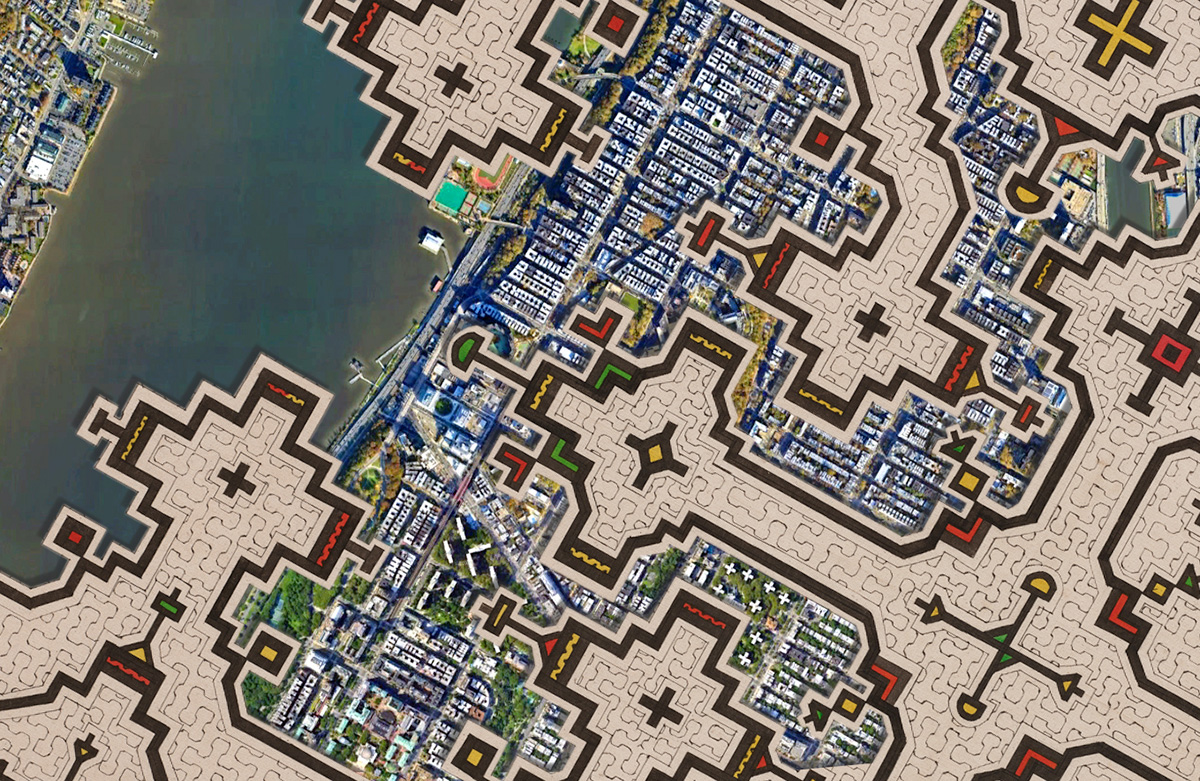
In parallel with this year’s United Nations Permanent Forum on Indigenous Issues (UNPFII 2024), CTHQ will accompany each other on a walk through ancestral Lenape territory focused on land protection and reclamation, with the historical dispossession and current gentrification of Harlem paralleling land invasions in the Amazon. Opening a narrow path through the trees by walking is the way Indigenous communal boundaries are marked in the rainforest. This mode of advancing by turning and turning is also the guiding energy of the Shipibo design system.
Indigenous leaders will be walking with participants through Harlem, following an imaginary design traced in a similar way around the urban matrix, from the Tree of Hope, through local effort of land reclamation for community gardens and neighborhoods proposed for landmarking, all the way to The Shipibo Conibo Center headquarters. There, members of the Guardia Indigena will be on a livestream from the Amazon to explain the practice and necessity of making linderos in the face of often violent land invasions. After the walk, participants and CTHQ will dance. The Minga, or work party celebrating the end of a week’s work at the UNPFII, will be held at the Center, honoring Shipibo artist Sara Flores.
This event is part of a series developed by CTHQ, Creative Time’s gathering space for art and politics. Parallel Walks is a series of artist-led walks that take place in two disparate sites that are connected through a shared political, social, contextual, or geographic theme. To learn more about artist Sara Flores, join earlier in the week at CTHQ for Jungle whispers and forest echoes on Wednesday, April 17th at 6.00 pm.
Plan your trip
Meeting Spot: Tree of Hope, located in the center meridian of Adam Clayton Powell Junior Boulevard at the corner of West 131st Street in Manhattan.
Transit: Meeting spot is 0.4 miles from the 135th St, 2 and 3 subway station, and from the 125th St, A, C, B, D subway station.
About the Artists & Partners
The Shipibo Conibo Center is a broad experiment in art, culture, politics and the afterlife—an art project in the form of a nonprofit cultural organization headquartered in West Harlem, NYC on ancestral Lenape land, with a focus on Indigenous self-determination and territorial sovereignty as well as visual arts, music, and ethnobotanical research.
Coshikox is the representative body of the Shipibo-Konibo-Xetebo People of the Peruvian Amazon, bringing together its 176 Indigenous communities spread over more than 8 million hectares, to organize their efforts to reclaim the ancestral territory under the framework of a Unified Indigenous Nation.
Guardia Indígena Shipibo is an association of members of Indigenous communities from the Peruvian Amazon established to provide protection to their territories and their bodies of water. Within the framework of respect for the worldview and cultural identity of the Shipibo People, the organization formed in response to the advance of illegal economies, deforestation, and other territorial threats.
New Red Order (NRO) is a public secret society facilitated by core contributors Jackson Polys, Adam Khalil, and Zack Khalil. NRO works with networks of informants and accomplices to create grounds for Indigenous futures.
Black Gotham Experience (BGX) creates media at the intersection of scholarship and aesthetics that illustrates the impact of the African Diaspora. BGX reimagines spaces directly impacted by the African Diaspora as human stories explored through interactive walks, talks, events, and art.
Save Harlem Now! is a not-for-profit advocacy organization dedicated to protecting, preserving and celebrating Harlem’s irreplaceable built heritage.
Sara Flores is one of the foremost contemporary painters emerging from the Amazonian basin. Informed by the interconnectivity of the rainforest ecosystem, her complex and intricately geometric works render an overall image with a complex, vibrational power, and can be seen as a visual manifesto for reciprocal values and spiritual ethics of the Shipibo People.
Dioganhdih is a queer Indigenous hip-hop artist and producer making waves in space where cis+heteronormative culture often remains unchallenged. Shouldering the strength and resilience of their Kanien’kehá:ka and Tsa’la’gi lineage, Dio’s performance is a poetic and lyrical affront to colonialism.
